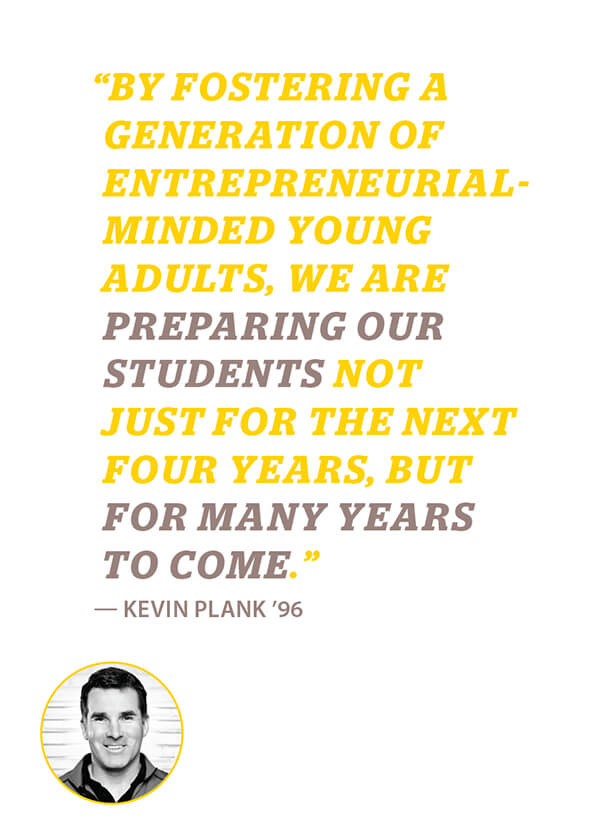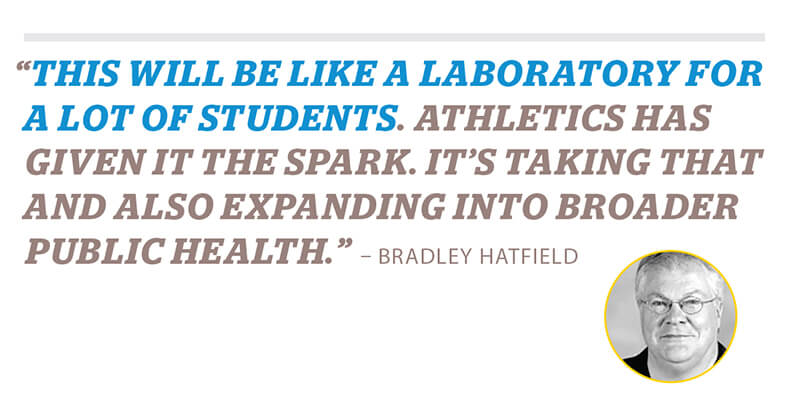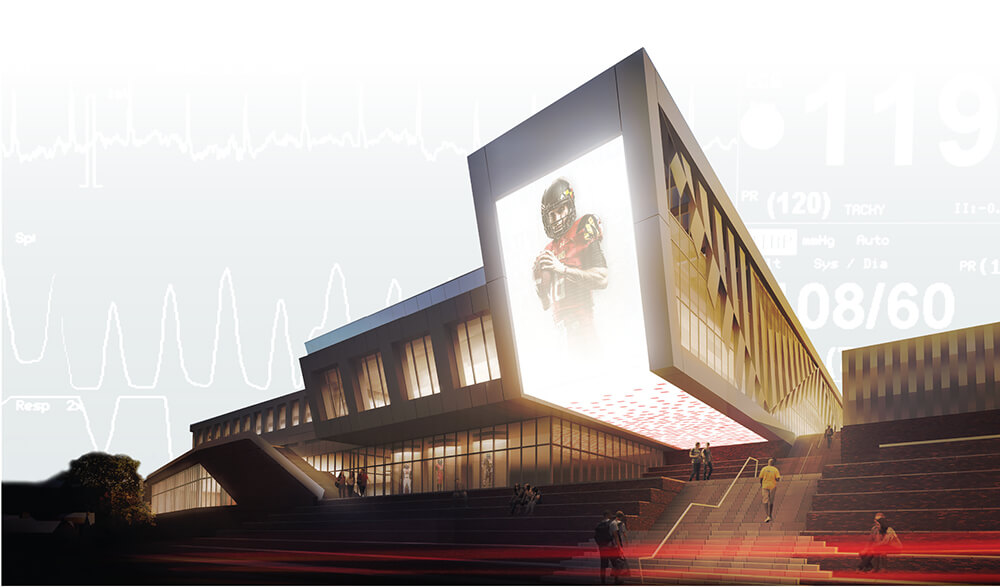- May 02, 2015
- By Maryland Today Staff
It has hosted Elvis Presley, President Kennedy, a groundbreaking ping-pong match and basketball games that made history. (click for timeline)
But the William P. Cole Jr. Student Activities Building, better known as Cole Field House, doesn’t house just Maryland’s memories. Today, the building holds the university’s ambitions.
This spring, the university will begin designing a reimagined and reinvigorated Cole, one that will be a hub for innovation and a national model for integrating athletics, academics and research.
The $155 million project, approved by the state Board of Regents in December, will preserve the building’s façade on Campus Drive and honor its legacy, while creating the Terrapin Performance Center, featuring a full-size indoor football field and new training facilities; a new venue for the Academy for Innovation and Entrepreneurship; and the new Center for Sports Medicine, Health, and Human Performance.
“The new Cole Field House is not just an important project for Maryland athletics, it is a signature project for our entire institution,” says university President Wallace D. Loh.
 Students from across campus will have opportunities to take new courses, explore their boldest ideas and create new companies at Cole—a major reason that Under Armour founder and CEO Kevin Plank ’96 helped launch the project with a $25 million gift.
Students from across campus will have opportunities to take new courses, explore their boldest ideas and create new companies at Cole—a major reason that Under Armour founder and CEO Kevin Plank ’96 helped launch the project with a $25 million gift.
“This project brings together two of my favorite passions, Maryland athletics and entrepreneurship,” he says. “The lessons I learned on the football field in College Park continue to fuel my entrepreneurial spirit and shape my professional approach. By fostering a generation of entrepreneurial-minded young adults, we are preparing our students not just for the next four years, but for many years to come.”
Construction is scheduled to start in December, meaning it won’t be long before new names will be added to the legacy left by Elvis, Lefty and Gary.
Academics
The next Kevin Planks won’t have to start their new technology, social endeavor or business in their grandma’s basement, like he did. The Academy for Innovation and Entrepreneurship, which will be in the new Edward St. John Teaching and Learning Center as well as at Cole, is focused on nurturing that creativity among the 37,000-strong student body.
The Academy at Cole Field House will expand the more than 100 innovation and entrepreneurship courses already offered each year at UMD. It will also serve as a clearinghouse for experiential learning opportunities, such as internships and competitions, and it will house the Innovation Shell, a hybrid incubator-classroom space (with a rapid prototyping lab) where students can bring their ventures to life.
The academy will draw expertise from across campus, including UMD’s 12 schools and colleges as well as the Maryland Technology Enterprise Institute, the Dingman Center for Entrepreneurship, the Center for Social Value Creation, the Center for Philanthropy and Nonprofit Leadership and the Office of Technology Commercialization.
Dean Chang, associate vice president for innovation and entrepreneurship, says budding UMD inventors will be able to “graduate” into Cole with an area where they can build prototypes and even start selling products.
“At some point, your garage is no longer adequate,” he says. “Cole has a unique opportunity to be this next-step place.”
The potential for programming directed at student-athletes is a special area of interest for Plank, who founded Under Armour while on the Terps football team and later launched the now-international Cupid’s Cup Business Competition at the Dingman Center.
“Any young athlete with hustle, a big idea or the will to do something special will want to be at Maryland and will make their home at Cole Field House,” Plank says.
Research
The new Cole Field House also has the potential to redefine how we move. The creation of the Center for Sports Medicine, Health, and Human Performance will bring together experts from UMD’s A. James Clark School of Engineering, School of Public Health, College of Agriculture and Natural Resources, Department of Intercollegiate Athletics and the University of Maryland, Baltimore’s School of Medicine to push the boundaries of human physiology.
Sidebar: Research with More Muscle
 Does an ROTC student have a running gait that makes him susceptible to injury? How can a robotic glove improve hand rehabilitation for stroke victims? How do changes in nutrition affect a “weekend warrior’s” performance?
Does an ROTC student have a running gait that makes him susceptible to injury? How can a robotic glove improve hand rehabilitation for stroke victims? How do changes in nutrition affect a “weekend warrior’s” performance?
These are the sorts of questions the center will explore, says Bradley Hatfield, the UMD chair of kinesiology spearheading the project.
“This will be like a laboratory for a lot of students,” Hatfield says. “Athletics has given it the spark. It’s taking that and also expanding into broader public health.”
The center will feature 23,000 square feet of clinical space to treat an estimated 60,000 people a year in the D.C. region. An additional 16,000 square feet will be dedicated to studying areas such as concussion and traumatic brain injury, muscle-brain physiology and biochemistry, and exoskeleton-robotic treatments.
The center will bridge the gap between Baltimore’s medical resources and UMD’s engineering resources, says Andrew Pollak, professor of orthopaedics and head of the Division of Orthopaedic Traumatology at the University of Maryland School of Medicine.
“This is a huge, huge tool,” Pollak says. “We are taking a world-class clinical program and linking it to a world-class technical program.”
Athletics
The third component of the new Cole will be the Terrapin Performance Center, tailored to be the premier athletic training facility in Division I sports.
It will include an indoor, all-season, regulation-size practice field under Cole’s iconic domed roof, an adjacent strength and conditioning facility, two outdoor practice fields, a team meeting room, coaches’ offices, a team locker room and a tunnel that leads to the stadium on game days. The fields will also be made available for intramural sports.
 "By providing them with a world-class practice, training and strength and conditioning facility, as well as expansive meeting space, our student-athletes will boast a competitive advantage as new members of the Big Ten Conference,” says Kevin Anderson, director of athletics.
"By providing them with a world-class practice, training and strength and conditioning facility, as well as expansive meeting space, our student-athletes will boast a competitive advantage as new members of the Big Ten Conference,” says Kevin Anderson, director of athletics.
Gary Williams ’68, who built his storied 22-year career as men’s basketball coach at Cole Field House, is now fundraising chief in athletics. As much as he treasures his memories there, he says, “The time is right to revitalize Cole Field House.”
“My view is this,” Williams says. “If you want excellence, you have to surround yourself with excellence. If you want to be the best, you need the tools to be the best.” TERP
